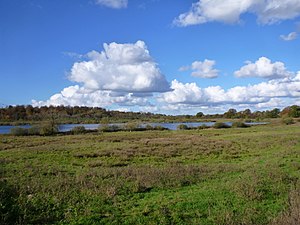Lütjensee and Hochfelder See south-east of Gut Bothkamp
|
Lütjensee and Hochfelder See south-east of Gut Bothkamp
|
||
| location | Between Bordesholm and Preetz , Plön district , Schleswig-Holstein | |
| surface | 155 ha | |
| Identifier | 128 | |
| WDPA ID | 164529 | |
| Geographical location | 54 ° 12 ' N , 10 ° 9' E | |
|
|
||
| Sea level | from 24 m to 33 m | |
| Setup date | 1990 | |
Luetjensee and Hochfelderstrasse lake southeast Good Bothkamp is a nature reserve in the Schleswig-Holstein communities Kirchbarkau , Bothkamp and Warnau in preetz-land in the district of Plön .
description
The 155 hectare nature reserve is registered under number 128 in the directory of nature reserves of the Ministry for Energy Transition, Agriculture, Environment, Nature and Digitization . It was expelled at the end of 1990 (date of regulation: December 13, 1990). The nature reserve is part of the FFH area "Area of the Upper Eider including lakes" and is almost completely surrounded by the landscape protection area "Bothkamper See, Valley of the Drögen Eider and the surrounding area". The responsible lower nature conservation authority is the district of Plön.
The nature reserve is located in a moraine landscape south of Kirchbarkau between Bordesholm and Preetz . It sets during Weichselian arisings, extensive lowland area with the two lakes Luetjensee and Hochfelderstrasse lake under protection. The lakes, which are traversed by watercourses and have a common drain to the Bothkamper See , are surrounded by extensive silting zones . The lowland area is predominantly natural. There is a large area of fracture and wet forests and reed zones and sedge taken. In addition, tall herbaceous vegetation and wet grassland can be found. The slightly higher and drier locations are dominated by grassland . There are also hedgerows as well as isolated deciduous forest communities and woody plants.
The grassland areas are used for agriculture. Some areas are grazed extensively with Galloway cattle . The grassland areas are no longer drained and so wet.
Flora and fauna
The quarry forests are primarily formed by willows and alders. For example, gray willow , ear willow and black alder occur, sometimes also the ash tree . The reeds are formed from reeds, narrow-leaved and broad-leaved cattails as well as common pond rush , water plumes and hedgehog cob .
In the nature reserve, various sedges and rushes as settle Carex Acutiformis , Carex paniculata , Schlanksegge , Scheinzyperngrassegge , Wiesensegge , Carex rostrata , Carex hirta , Carex Disticha , Steifsegge , Carex paniculata , Walzensegge , members of Rush , Blue-green bulrush and Tonquil . Besides resettle many more that are adapted to moist locations plant species, including forest mantels , marsh reed grass , Glyceria fluitans , swamp trident , Equisetum fluviatile , Iris pseudacorus , Straußgilbweiderich , Common loosestrife , marsh chickweed , Epilobium hirsutum , bittersweet nightshade , Burning Crowfoot , Creeping Buttercup , meadow buttercup , brooklime , Veronica scutellata , hypericum tetrapterum , Galium palustre , Galium uliginosum , pennywort , Lotus pedunculatus , Myosotis scorpioides , bitter Schaumkraut , Eupatorium , Narrow-shopping , water hemlock , great water dock , shore Wolfstrapp , sump blood eye , Rorippa palustris , Lythrum salicaria , ragged robin , Thelypteris palustris , Skullcap and water mint .
The two lakes in the nature reserve are home to yellow pond rose and white water lily , small duckweed and multi-rooted pond lens, and in particular the Lütjensee, also frog bite and water feather . Diving leaf vegetation is primarily represented by marsh pond threads in the Hochfelder See. Chance are also stoneworts , especially the fragile Stonewort find.
The pastures and herbaceous corridors provide a habitat for numerous butterflies , including small fire butterflies , land maps , C-butterflies , aurora butterflies , small meadow birds and lemon butterflies . The wet meadows provide a suitable habitat for the marsh insect. The reed beds are the habitat of the Marsh Harrier . The area is used by the sea eagle for foraging.
Others
The nature reserve, which is managed by the Schleswig-Holstein State Association of the German Nature Conservation Union , borders in many cases on agricultural areas. To the west it borders on wooded areas, to the north and east it borders in places on public roads. In the north and east there are hiking trails on the edge of the protected area. Information boards are set up at these. To the east and south of the Hochfelder See there are viewpoints from which the nature reserve can be partially viewed.
Web links
- NABU nature reserve "Lütjensee - Hochfelder See southeast of Gut Bothkamp" , NABU Schleswig-Holstein
- Lütjensee and Hochfelder See southeast of Gut Bothkamp , leaflet from the Ministry of Agriculture, Environment and Rural Areas of Schleswig-Holstein (PDF, 716 kB)
Individual evidence
- ↑ State ordinance on the nature reserve "Lütjensee and Hochfelder See southeast of Gut Bothkamp" of December 13, 1990 , state regulations and state case law, state government Schleswig-Holstein. Retrieved October 23, 2017.
- ^ Area of the Upper Eider including lakes , profiles of the Natura 2000 area, Federal Agency for Nature Conservation . Retrieved September 20, 2019.
- ↑ a b c Joachim Stuhr: Vegetation of the Hochfelder See, the Krebssee (Lehmrade), the Lottsee, the Lütjensee (Bothkamp), the Lüttauer See, the Sarnekower See, the Schmalsee and the Schwarzsee , vegetation studies of lakes of the FFH habitat type 3140 , 3150 and 3160 in FFH areas 2007, State Office for Nature and the Environment of Schleswig-Holstein (PDF, 3.9 MB). Retrieved October 23, 2017.
- ^ Supervision of protected areas in Schleswig-Holstein , State Office for Agriculture, Environment and Rural Areas (PDF, 275 kB). Retrieved October 23, 2017.



